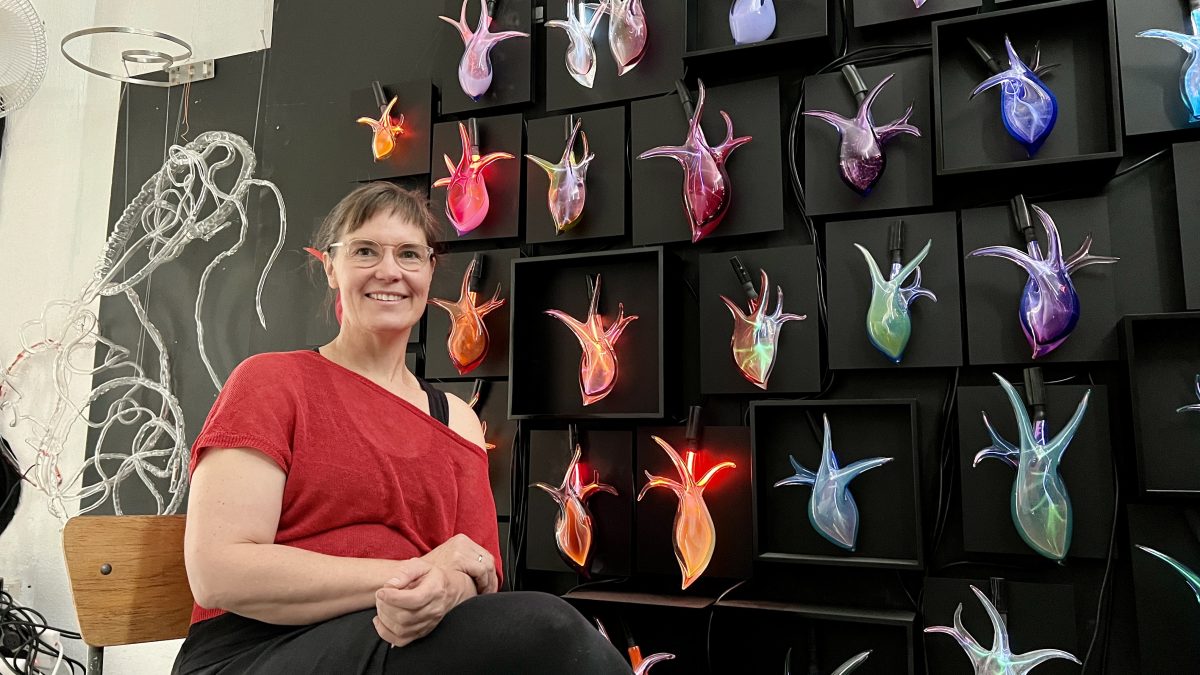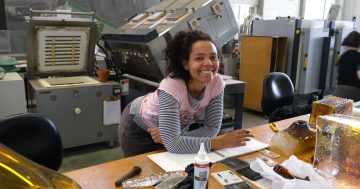
The glass heart wall resides in Harriet Schwarzrock’s home studio in Queanbeyan. Photo: James Coleman.
After years of making hearts glow, Harry is moving on to blood vessels now.
Queanbeyan glass artist Harriet (Harry) Schwarzrock has become famous in the local arts community for her wall of glass plasma hearts, pulsating with electricity in much the same way as a fluorescent tube or plasma lamp.
“It’s basically a sculptural version of a plasma ball you might see in a science museum,” she says.
She’s now reworking the technology as thin, curled tubes of glass ahead of an exhibition at the Canberra Museum and Gallery (CMAG) next year.
“I used the stylised form of the heart as a way of considering relationships, and then this opportunity to work with gas discharge illumination has meant I’m able to consider electricity in the body,” she explains.
“I’m now leaning into ideas about proximity, and how just being near these electromagnetic fields changes the form of the illumination.”
In other words, just as the plasma in the hearts appear to charge towards your hand when you place it close, two tubes of different gases will work the same way.
The hearts featured in an exhibition at the National Portrait Gallery in 2021 called ‘Australian Love Stories’, but more recently, the home studio belonging to her and her partner Matthew Curtis formed one of the stops on the Queanbeyan Arts Trail in October.
She’s been toying with them since she attended the Sydney College of the Arts in the 1990s.
“It’s something I enjoy because of the molten fluidity of the material, that idea of form following function,” she says.
Harry has even completed a masterclass at the Canberra Glassworks and has taken tips from artists around the world.
“Predominantly, in this wacky kind of field, my main mentors are overseas, and I’ve had the great fortune of being able to go over for research trips over the last few years,” she says.
She describes the process as a “bit convoluted and ridiculous” and a blend of traditional glass-blowing techniques employed by the neon lighting trade.
It starts normally enough, melting glass into a heart shape using kilns and blow-tubes. A hole is left at one end of the shape for the electrode, which is basically a single wire with two exposed ends for current to jump between. The hearts are then returned to the kiln and vacuumed out to create a void for inert gas, such as neon, argon, crypton or zygon.
“Once I can touch the glass, I open the doors, close off the vacuum, and begin inserting inert gases from the far right of the periodic table,” Harry says.
“Neon gives off light in the red end of the spectrum … and the other three gasses give off colours close to the blue end of the spectrum.”

Heart to heart. Photo: James Coleman.
When plugged in, electricity turns the gas into plasma through a process called ‘excitation’ – similar to what you see in lightning or stars – but in a glass ornament that can be hung from the wall of your home and is safe to the touch.
“It’s really wonderful having the studio open and having people come in and interact with the work,” she says.
“It’s a small sense of being able to see something’s that invisible, or something you think you might not be able to understand.”
The hearts are for sale at Canberra Glassworks and the Suki & Hugh Gallery in Bungendore, and “occasionally, people will buy these”.
“They are quite pricey, approximately $2400 each. They’re not for everybody, but a lot of work and research has gone into producing them.”
The Curtis Glass Art home studio in Queanbeyan is open by appointment only. Visit the Curtis Glass Art for more information.
Original Article published by James Coleman on Riotact.








